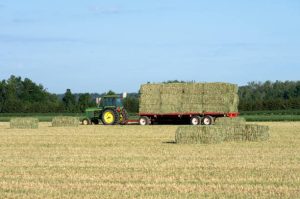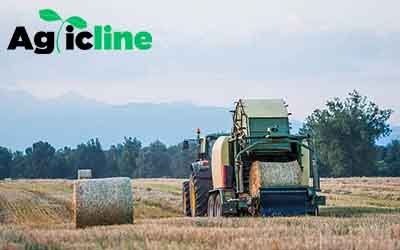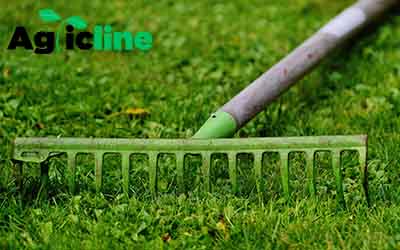A baler is a piece of agricultural equipment used to compress and bundle harvested crops, such as hay, straw, or silage, into compact and manageable bales.
By utilizing a baler in the haymaking and forage production process, farmers can improve efficiency, reduce labor requirements, and preserve the quality of their crops for storage, transport, and livestock feeding.
These bales are easier to handle, transport, and store. Balers play a crucial role in the haymaking and forage industry.

Types of Balers
See below;
Round Balers
Round balers create cylindrical bales by continuously collecting and compacting the crop material as it is fed into the machine. Once the desired size is reached, the baler wraps the bale with twine or netting for secure binding.
Square Balers
Square balers compress the crop material into rectangular or square-shaped bales.

They collect and compress the material using a plunger, which moves back and forth, creating uniform and tightly packed bales. Square balers often use twine or wire to secure the bales.
Small Square Balers
Small square balers are similar to square balers but produce smaller bales. They are commonly used for small-scale farming operations or when handling smaller quantities of forage.
Functions and Benefits of Balers
Here are the specific functions;
Efficient Harvesting
Balers enable efficient harvesting by quickly and effectively transforming loose crop material into compact bales. This reduces the time and effort required for manual collection and stacking.
Storage and Transportation
Baling allows for efficient storage and transportation of crops. The compact bales are easier to stack, store in sheds or barns, and transport to market or storage facilities.
Improved Crop Quality
Balers help preserve the quality of forage crops by minimizing exposure to moisture, sunlight, and external contaminants. The tightly packed bales protect the crop from spoilage, maintain its nutritional value, and reduce the risk of mold or rot.
Cost Savings
Using balers can lead to cost savings in labor and equipment. The mechanized process of baling is faster and more efficient than manual collection and stacking. It also reduces the need for additional handling equipment, saving both time and resources.
Versatility
Balers are adaptable to different types of crops and can handle a range of forage materials, including hay, straw, and silage. This versatility makes them essential equipment for various farming and livestock operations.
Maintenance of Baler
Proper maintenance of balers is crucial to ensure their efficient and safe operation. Here are some maintenance tips:
- Regularly inspect and clean the baler, removing debris or residue that may hinder its performance.
- Lubricate moving parts as recommended by the manufacturer to reduce friction and prevent wear.
- Check and replace worn or damaged belts, chains, or other components to maintain optimal functioning.
- Keep the baler stored in a dry and protected area when not in use to prevent rust and deterioration.
Parts of balers
It’s important to note that the specific design and configuration of baler parts can vary depending on the type, brand, and model of the baler. Different balers may have additional features or variations in their parts to suit their specific design and functionality.
- Pickup: The pickup is located at the front of the baler and is responsible for gathering the crop material from the field. It consists of tines or pickup teeth that rotate, collect the crop, and feed it into the baler.
- Feeding System: The feeding system transports the crop material from the pickup to the compression chamber. It may include augers, belts, or chains that move the crop horizontally or vertically, ensuring a steady flow into the baler.
- Compression Chamber: The compression chamber is where the crop material is compressed and formed into bales. It consists of walls or sides that can move closer together or an inner plunger that compresses the material. The chamber is designed to apply pressure and create tightly packed bales.
- Plunger: The plunger, also known as the ram, is a large hydraulic or mechanical component that moves back and forth within the compression chamber. It pushes the crop material into the chamber, compressing it to form a dense bale. The plunger is driven by a hydraulic system or mechanical linkage.
- Bale Formation and Ejection System: Once the bale reaches the desired size, the bale formation and ejection system activate. It can include mechanisms such as bale chambers, bale chambers, or bale wrapping systems. These systems shape the bale and wrap it with twine, netting, or plastic wrap to secure it before it is ejected from the baler.
- Knotter (for twine tying): In balers that use twine to bind the bales, there are knotter mechanisms. These mechanisms tie knots with the twine to secure the bale. The twine is threaded through the knotter, and as the bale is formed, it creates loops and knots to hold the bale together.
- Hydraulic System: Balers often have a hydraulic system that powers various components, including the plunger, pickup lift, and bale ejection system. The hydraulic system consists of a hydraulic pump, valves, hoses, and cylinders that provide the necessary force and control for the baler’s operation.
- Control Panel: Modern balers feature a control panel that allows the operator to monitor and adjust the baler’s settings and functions. The control panel may include displays, buttons, or levers to control the speed, tension, and other parameters of the baler.
- Frame and Chassis: The frame and chassis provide the structure and support for the baler. They are designed to withstand the forces involved in baling operations and provide stability and durability.
- Safety Features: Balers often incorporate safety features such as guards, shields, emergency stop buttons, and safety sensors to ensure the operator’s safety during operation and maintenance.
Things to consider before getting a baler
Before getting a baler, there are several important factors to consider to ensure you choose the right baler for your specific needs. Here are some key considerations:
- Bale Size and Type
Determine the desired bale size and type that aligns with your requirements. Consider the size and weight of bales that will be suitable for your storage, transport, and feeding purposes.
- Crop Type and Volume
Evaluate the type and volume of crops you will be baling. Different balers are designed to handle specific crops, such as hay, straw, silage, or biomass.
Ensure the baler you choose is capable of efficiently baling the specific crops you work with and can handle the volume you anticipate.
- Baler Capacity and Speed
Assess the capacity and speed of the baler. Consider the output required to meet your baling needs efficiently. Balers come in different sizes and have varying capacities, so choose a baler that can handle your expected workload effectively.
- Power Source
Determine the power source that is most suitable for your operation. Balers can be powered by tractor PTO (Power Take-Off) or have their own engine. Consider your existing equipment and power availability to decide which power source is more practical for your needs.
- Available Space and Access
Evaluate the available space where the baler will be operated, stored, and maintained. Consider the access points, such as doorways or gate widths, to ensure the baler can be easily maneuvered into the required areas.
- Maintenance and Service
Research the maintenance requirements and availability of service and support for the baler you are considering. Look for a reputable brand with a reliable dealer network or service providers who can assist with maintenance, repairs, and access to spare parts.
- Budget
Determine your budget and consider the investment cost of the baler. Balers can vary significantly in price depending on their features, capacity, and brand. Consider the long-term value and potential return on investment the baler can provide for your operation.
- Operator Skill and Training
Assess the skill level of the operators who will be using the baler. Some balers may require more technical knowledge and expertise to operate effectively. Ensure that you have trained personnel or access to training resources to operate the baler safely and efficiently.
- Reviews and Recommendations
Research and read reviews or seek recommendations from other farmers or agricultural professionals who have experience with the baler models you are considering.
Their insights and feedback can provide valuable information to inform your decision-making process.



